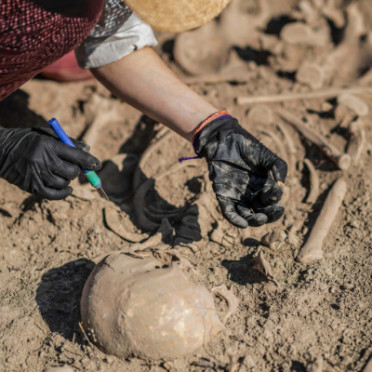Isabelle Séguy
INED researcher Isabelle Séguy studies sociodemographic behaviors from a historical perspective using archeological data.
(Interview conducted in April 2024)
Why is it important in your research to have access to paleo-demographic data on population groups who lived after the colonial period?
The pre-Hispanic and post-colonial populations of Mexico discovered by archeologists display important particularities. The types of settlement these people practiced brought highly differentiated ethnic-cultural groups into proximity with each other on the same territory. Nomadic groups and powerful cities existed side by side, and the clashes between them could be violent. The Spanish conquest and the sudden radical changes it caused strongly impacted cultures and individuals. Funerary practices, for example, differed considerably from those found in Europe in the same periods. All this means that researchers need to adapt existing methods of paleo-demographic analysis, initially developed for European contexts, to study these Central American sites.
Having access to Mesoamerican osteological collections opens up new research avenues. For example, can we observe the impacts of colonialism and forced acculturation on the skeletons of post-colonial populations? If so, researchers could look for those biological and demographic markers on skeletons of French and European groups living in Antiquity and the Early Middle Ages, as they too were subjected to wide-ranging cultural mixing.
It should be stressed that our partnership agreement with Mexico’s Instituto Nacional de Antropologia e Historia (INAH) goes beyond access to paleo-demographic data. It is also an ethical, equitable scientific collaboration respectful of Mexican heritage and Mexican researchers. To date, there are few peer-to-peer collaborations with emerging countries in the human and social sciences; the participation of those countries is usually limited to providing data.
Can you tell us more about Mexico’s Instituto Nacional de Antropologia e Historia?
INAH’s official mission is to conduct scientific research studies in social anthropology, archeology, physical anthropology, and history. The Institute is also in charge of protecting, preserving, and restoring the country’s monuments and material heritage, and promoting and diffusing its research and other work.
INAH is the oldest and most important anthropological research institute in Latin America. It offers each and every inhabitant of Mexico free access to their history. It is also the only Latin American institution to have a specific research section in paleo-demography and anthropological demography: the Direccion de Antropologia Fisica (DAF). INED’s collaboration agreement was signed with that section, which is in charge of all of the nation’s bioanthropological and paleo-demographic studies.
How did this partnership with INED come about?
It goes back to the 2001 convention of the IUSSP [International Union for the Scientific Study of Population] Jean-Pierre Bocquet-Appel organized a session on paleo-demography there—our first opportunity for exchanges with Mexican colleagues. Those colleagues—all of them women—were interested in the rigorous methods used by French paleo-demographers and expressed a wish to engage in further academic dialogue and exchanges with us.
Several year later, in 2015, I hosted a doctoral student named Géraldine Granados for a year at the University of Nice/CNRS CEPAM research laboratory [CEPAM: Cultures and Environments: Prehistory, Antiquity, Middle Ages] in the framework of a Mexican-funded academic mobility grant (CONAHCYT). Her thesis was on the vulnerability of past populations, as attested by findings at the Monte Alban site. Granados was a bio-anthropologist with solid training in demography.
During her stay there were long discussions about whether the methods Luc Buchet and I developed in the Manuel de Paléodémographie could be adapted to Mesoamerican data. Also during her stay we laid the groundwork for our collaboration with INAH.
Géraldine Granados coordinates the multiannual research project “Études paléodémographiques des sociétés préhispaniques, coloniales et modernes du Mexique,” approved by INAH’s committee of experts and funded at the national level.
What studies have you programmed for the near future?
The multiannual research project just cited is composed of several distinct studies.
One concerns the Mayas of the nineteenth century, in whom a high prevalence of kidney problems has been found; the other focuses on the cemetery of San Juan de Dios Hospital, containing the remains of highly vulnerable groups who lived during the seventeenth and/or eighteenth centuries. The third project will evaluate the impact of colonization on a range of dominated groups. We’ve applied for a grant from the European Union’s Marie-Sklodowska-Curie Actions for that particular study. If we receive it, the project will be hosted at INED under my supervision.
Source : Isabelle Séguy and Luc Buchet, 2011, Manuel de Paléodémographie (INED Manuels et Textes Fondamentaux), 432 pp [FR]

